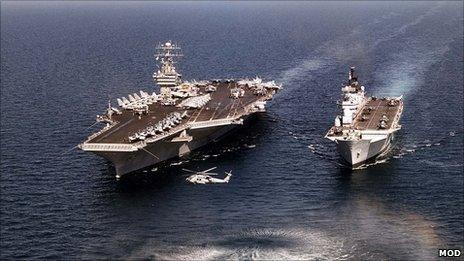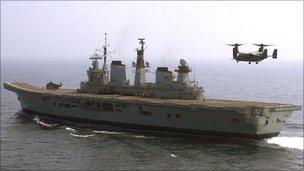Navy's £5bn aircraft carrier conundrum
- Published

US carriers, pictured left, are much bigger than UK ones, like HMS Illustrious shown on the right
The Royal Navy has got the go-ahead for the planned two big new aircraft carriers - but at a price. And the announcement is unlikely to end the arguments over them.
What is it about aircraft carriers? They became the poster children of the strategic defence review.
They are very big and expensive. But it is not just that which raises people's hackles, it is what they symbolise to many. Imperial echoes? Superpower pretensions? Big-ship admirals craving past glories?
And have the carriers totally skewed defence plans? Or is it Afghanistan that has done that?
Certainly, the critics never miss an opportunity to attach such terms of abuse as "behemoths" and "Cold War relics" to the carriers.
The term "white elephant" is likely to get a boost from the revelation that they could initially have to operate without their planned aircraft.
To their supporters, though, they are potentially the most useful and flexible defence assets that Britain could have for what is, by common consent, an exceptionally uncertain future.
They are, so the argument goes, ideal and adaptable platforms for everything from high-tech war to humanitarian relief.
Capability gap
But even some in the Navy are said to worry that it is paying too high a price for the new carriers, never mind the impact on other defence capabilities.
When they first got the green light in Labour's 1998 defence review, the plan was that the Navy would also consist of 32 destroyers and frigates.
That number has already fallen to the low-20s. In the House of the Commons, Prime Minister David Cameron confirmed the number would fall again to 19.
According to some, that will leave the Navy ill-equipped to carry out traditional tasks of maintaining a presence in key regions and protecting shipping from such threats as piracy. It just will not have enough ships to go round.

The Royal Navy's HMS Illustrious is a third of the size of the proposed new aircraft carriers
The fact that the Navy is losing its current flagship - the existing aircraft carrier, HMS Ark Royal - as part of the price to be paid for the new ships is also a big blow. She was due to retire in 2014.
With the departure of the Harrier force as well, Britain will essentially have aircraft carriers but no fixed-wing aircraft to fly from them until 2020.
Some will see that as a serious capability gap which raises doubts about the Navy's ability to operate independently in that time, and is out of step with a stated ambition to operate globally.
A silver lining is that Britain will be buying what many see as a superior (and cheaper) version of the new Joint Strike Fighter than originally planned, to fly from one of the new carriers. It will also be redesigned so it can operate US and French naval aircraft too.
The Defence Secretary, Liam Fox, says the naval aircraft gap is not unprecedented, and happened for example when the Navy switched to Sea Harriers at the end of the 1970s.
But that was a gap of only about 18 months, while one of ten years raises many more questions over pilot training, retention, and maintaining skills.
Mr Cameron told the Commons the military advice was to keep the more capable Tornado strike aircraft, rather than the Harriers. He also said carrier air power was unlikely to be essential for the next 10 years, even if it might be more so later.
For all the arguments, senior admirals see the decision about carriers as a generational one that also represents a capability that can make a real difference to Britain's ability to exercise influence around the world.
It is a capability, they argue, that - if given up now - probably will never be revived.
Destroyer and frigate numbers, on the other hand, could more easily be rebuilt if circumstances or threats change.
But do they have to be so big? At 65,000 tonnes, they will be the largest warships ever built for the Navy. Only the US super-carriers, at around 100,000 tonnes, are bigger.
Inter-service rivalry
Indeed, the new carriers will be three times larger than the Navy's current ships Ark Royal, Illustrious, and Invincible (now in mothballs), which were never designed as full-size carriers.
They are mini versions that have performed above and beyond expectations over the years (not least in the Falklands), but never as proper carriers could.
Indeed, carrier advocates argue that British policymakers have simply forgotten how many options such ships can offer them.
There is, of course, the cost of the new ones - £5bn plus for the pair. But that is less than half the cost of a new US carrier, and half the cost of 10 years in Afghanistan, while the ships are scheduled to last 50 years.
But the cost arguments do not stop there. What about all the aircraft for the carriers and the escort ships that they will need to protect them?
Well, most of the aircraft and ships will be needed anyway if the RAF and Navy are to operate effectively at all in the future. So says the pro-carrier lobby, anyway.
It was back in the 1960s when the Navy last - unsuccessfully - tried to get a new generation of big aircraft carriers. They were torpedoed by a combination of economic crisis, a re-ordering of strategic priorities, and inter-service rivalry.
By all accounts, the inter-service atmosphere has been as bad if not worse now than it was then. On top of that, ministers have hinted that, but for a straitjacket of a building contract, at least one of the new ships would have been cancelled.
In as much as there has been a strategic debate about them, a lot of it has revolved around whether future military conflicts will look like Afghanistan again and again, and - if so - how should Britain approach them, and would carriers be valuable?
Or will things be very different, in this Pacific century when emerging powers like India and China are themselves trying to get into the carrier club? So, for governments, will "aircraft carriers in the water" be just as valuable as "boots on the ground"?